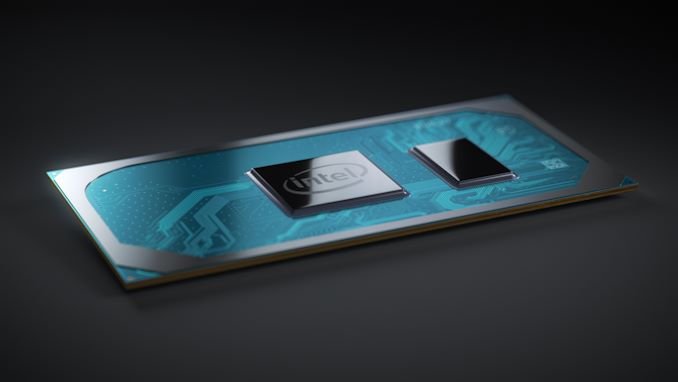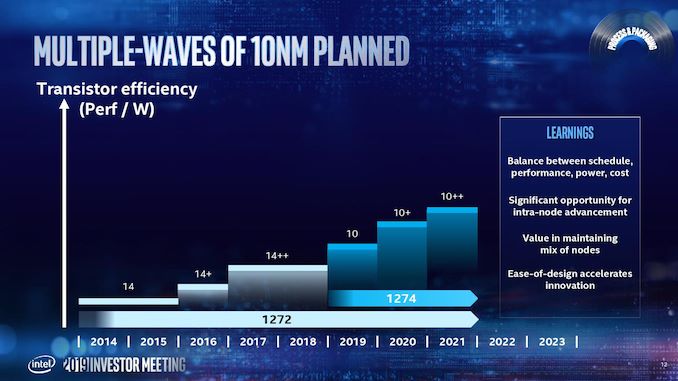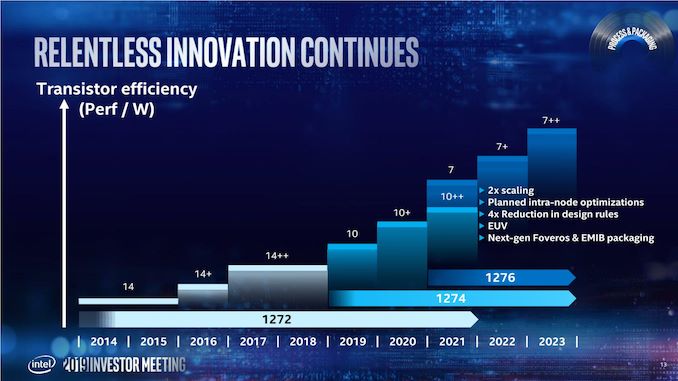Intel Q3 2019 Fab Update: 10nm Product Era Has Begun, 7nm On Track
by Anton Shilov on October 28, 2019 9:30 AM EST
After years of delays, Intel is finally shipping its 10 nm processors in high volume, and the company is preparing to fire up another fab to produce an even larger volume of 10nm products. Along with producing more of the company's existing Ice Lake-U/Y products, Intel is also planning for server CPUs and GPUs as well, with Ice Lake-SP CPU as well as the DG1 GPU already up and running in Intel’s labs. Meanwhile, even farther out, Intel is eyeing 2021 for the rollout of its EUV-based 7nm process.
During its earnings call on Thursday, Intel said that so far 18 premium systems based on its 10th Generation Core (Ice Lake) processors have been formally introduced and 12 more are expected in 2019. Right now, the company produces all of its 10 nm CPUs in Hillsboro, Oregon and Kiryat Gat, Israel. Starting next quarter, the company expects 10 nm chips to also ship from its Chandler, Arizona, fab, which will increase supply of Ice Lake processors and will get Intel prepared for a broader use of the manufacturing process that had caused company a lot of troubles.
In addition to client Ice Lake CPUs and Agilex FPGAs that are currently shipping, Intel’s 10 nm portfolio includes datacenter-grade Xeon (Ice Lake-SP) processors due in the second half of 2020, discrete DG1 GPU(s), an AI inference accelerator, and a 5G base station SoC. One thing to keep in mind here is that Intel will use different iterations of its 10 nm technology to make different chips.
Here is what Bob Swan, CEO of Intel, said:
“The Intel 10 nm product era has begun and our new 10th Gen Core Ice Lake processors are leading the way. In Q3, we also shipped our first 10 nm Agilex FPGAs. In 2020, we will continue to expand our 10 nm portfolio with exciting new products including an AI inference accelerator, 5G base station SoC, Xeon CPUs for server storage and network, and a discrete GPU. This quarter we have achieved power on exit for our first discrete GPU DG1, an important milestone.”
The big news here is that Intel produced the first samples of its DG1 GPU back in Q3, which means that the company now has actual silicon to work with. The chip will undergo at least one more iteration before it will be ready to ship commercially, but it is a good sign that Intel’s A0 DG1 GPU could be turned on. If Intel wants to launch these GPUs in mid-2020, then this is the right window to begin working on actual silicon.
One of the key operational challenges that Intel faces today in regards of its 10 nm fabrication process are yields, as they thwarted the technology from going HVM (high volume manufacturing) for years. According to Intel, yields are improving ahead of expectations for both for client and datacenter CPUs, though the company did not disclose any numbers.
7nm Technology on Track, 5nm in Development
Meanwhile, with their 10 nm evolution roadmap set till 2021, Intel’s manufacturing technology teams are now focused on 7 nm and 5 nm processes. Along with their 10nm status update, in their earnings call Intel has re-iterated that its EUV-based 7 nm technology was on-track for HVM in 2021, and that development of its 5 nm node was proceeding as planned.
According to Intel, having learnt from its 10 nm fabrication process and how its problems harmed its roadmap, the company has radically changed its approach to development of manufacturing technologies and actual products. The company no longer sets ultra-ambitious goals for scaling each node, but attempts to find a right balance between performance, power, cost, and timing. Furthermore, the manufacturer no longer designs products for a particular process, but intends to use the most optimal one it has at the moment. Overall, Intel says that it intends to get back to its usual process technology cadence and introduce brand-new technologies every 2 to 2.5 years, and recapture its process leadership in the future.
Intel’s first product to be made using its 7 nm manufacturing technology is its ‘big’ GPU for high performance computing that is due in Q4 2021, two years after the launch of the 10 nm Ice Lake CPU. Intel says that its 7 nm process is well on-track and the product will be released as planned. While Intel also plans to use 7+ and 7++ technologies in 2022 and 2023, the company is already working on its 5 nm process and is currently ‘engineering’ it, which means that the path-finding stage has been passed and fundamental things like materials and transistor structures were set.
Here is what Bob Swan, CEO of Intel, told analysts and investors on Thursday:
“We are on track to launch our first 7 nm based product, a datacenter-focused discrete GPU, in 2021, two years after the launch of 10 nm [products]. We are also well down the engineering path on 5 nm.”
Related Reading:
- Intel Begins Commercial Shipments of 10nm Ice Lake CPUs to OEMs
- The Ice Lake Benchmark Preview: Inside Intel's 10nm
- Examining Intel's Ice Lake Processors: Taking a Bite of the Sunny Cove Microarchitecture
- Intel Details Manufacturing through 2023: 7nm, 7+, 7++, with Next Gen Packaging
- Intel Process Technology Update: 10nm Server Products in 1H 2020, Accelerated 7nm in 2021
Source: Intel












59 Comments
View All Comments
bronan - Sunday, November 3, 2019 - link
@peevee no consumers at all, server/heavy workstation market products.Intel plays it smart, proof that you can make a products which beats the crap out of the other competition and your path becomes open for the consumer market.
However i am not sure if intel is looking to produce any consumer market gpu at all.
But honestly i am pretty sure if they want to they certainly have the money for it.
People tend to forget that intel is a giant, and has the financial power to do anything they set their minds at. I keep saying it when you wake a slumbering gaint you will feel the painfull result ;)
bronan - Sunday, November 3, 2019 - link
intel is not aiming at any consumer based gpu product, they clearly only aim at the computation market which is a thousands of dollars per gpu costing industryWhich uptill now is dominated by nvidia.
AMD has a small percentage in the high end super server segment currently. But that is not the big profit market and often those super computers get nvidia gpu's as well.
AMD has no answer yet for the top end enterprise gpu market, but i am sure intel is going to succeed to compete with nvidia sooner than later. When the giant wakes up, its showing its muscle soon. So question remains do they only go for top end user products or will they enter the smaller profit market (consumer products) as well.
We have to wait and see, my two cents is that it will take a while longer before intel thinks about making consumer based gpu. If had owned intel i would try to enter the top segment as well, and i might be wrong but profit wise consumer products is not a good starting market.
regsEx - Monday, October 28, 2019 - link
Here we go again. Intel's HP 10 nm is 50% denser than TSMC's HP 7FF.Gaming GPUs do not need PCIe 4.0 and even PCIe 3.0. 2080 Ti is fine with PCIe 2 x16.
Intel has a time to debug Xe while factories are being built. They are not rushing like AMD. But still any new architecture is quite buggy at the beginning. So was with Turing, so as RDNA right now.
tawm - Tuesday, October 29, 2019 - link
>Intel's HP 10 nm is 50% denser than TSMC's HP 7FF.Wrong.
Yojimbo - Monday, October 28, 2019 - link
Any yet that "wimper" probably covers a quarter of all AMD's CPUs. If Intel has 4 times the volume of AMD they only need to have 1/16th of their CPUs on 10 nm to cover a quarter of AMD's volume.ksec - Tuesday, October 29, 2019 - link
Did Anandtech even had a Icelake product sample to review? I haven't been following Intel closely ( Not interested in their lies ) but as far as I can tell there isn't a wide availability ( or even availability ) of Intel 10nm products on the market.They said they were aiming for product to customer's hand for Xmas. And we will see about that. Judging from the way things are going, They are basically stocking up as much 10nm as they can and try to make 10nm looking like yielding normally.
Uroshima - Monday, October 28, 2019 - link
"Xeon CPUs for server storage and network" ... just me or this does not sound as a serious data crunching type of Xeon?Jorgp2 - Monday, October 28, 2019 - link
That sounds exactly like the role of Atom server CPUs.They might push a 10nm Tremont based replacement for denverton
visualzero - Monday, October 28, 2019 - link
How did the saying go - Fool me once, shame on me. Fool me twice..How many times have we seen Intel making the same claims and then not follow up with proper execution? Now we should believe that they are shipping in high volumes, oh give me a break. Isn't it funny that they just released 10th gen 14nm CPUs to be their "bread and butter" also in mobile space during the next year.
visualzero - Monday, October 28, 2019 - link
Sorry, meant to post this to the top level.